Bird R.B., Stewart W.E., Lightfoot E.N. Transport Phenomena
Подождите немного. Документ загружается.

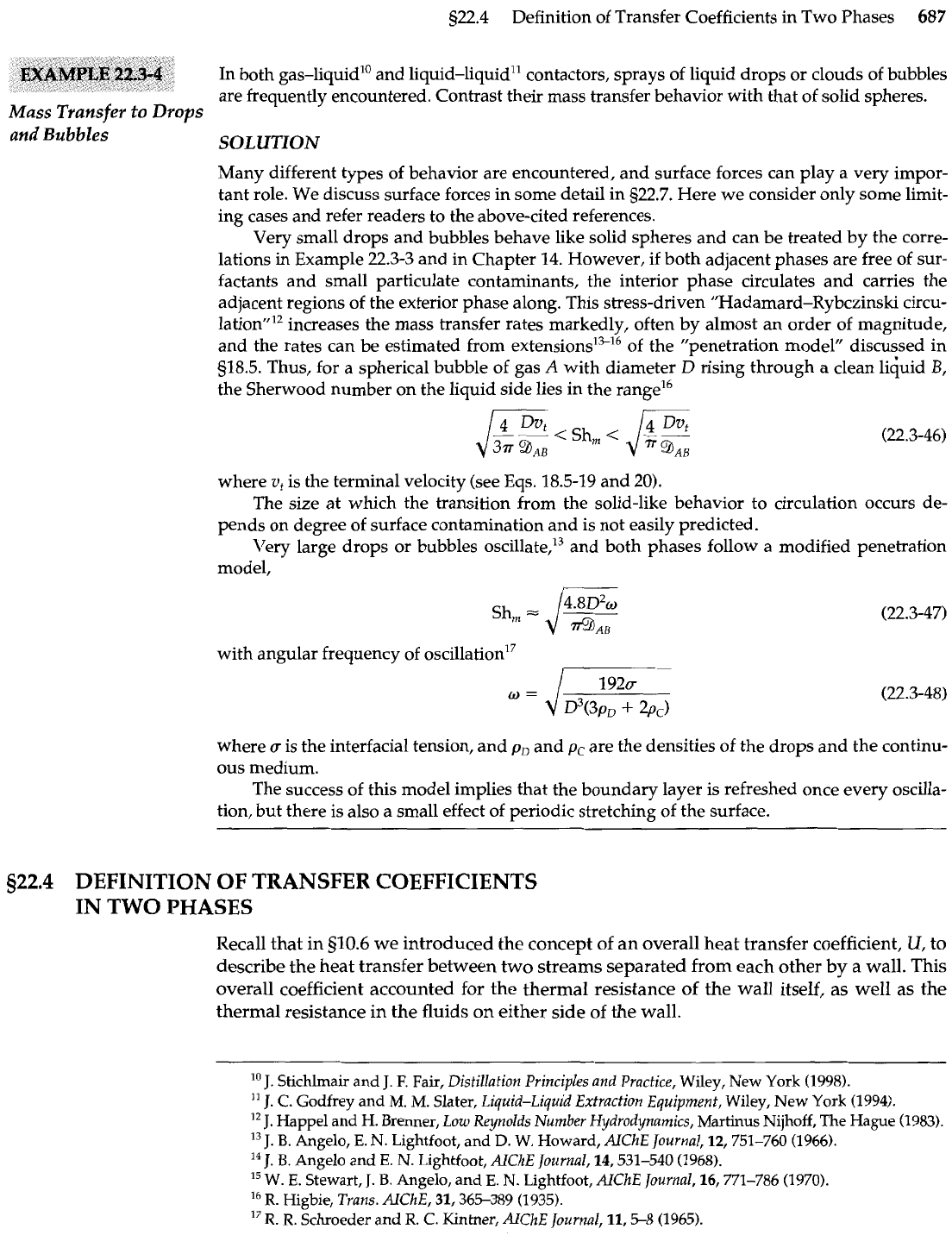
g22.4 Definition of Transfer Coefficients in Two Phases
687
In both gas-liquid10 and liquid-liquid" contactors, sprays of liquid drops or clouds of bubbles
are frequently encountered. Contrast their mass transfer behavior with that of solid spheres.
Mass Transfer to Drops
and Bubbles
SOLUTION
Many different types of behavior are encountered, and surface forces can play a very impor-
tant role. We discuss surface forces in some detail in 522.7. Here we consider only some limit-
ing cases and refer readers to the above-cited references.
Very small drops and bubbles behave like solid spheres and can be treated by the corre-
lations in Example 22.3-3 and in Chapter 14. However, if both adjacent phases are free of sur-
factants and small particulate contaminants, the interior phase circulates and carries the
adjacent regions of the exterior phase along. This stress-driven "Hadamard-Rybczinski circu-
lation"12 increases the mass transfer rates markedly, often by almost an order of magnitude,
and the rates can be estimated from of the "penetration model" discussed in
518.5. Thus, for a spherical bubble of gas
A
with diameter
D
rising through a clean likid
B,
the Shenvood number on the liquid side lies in the range16
where
v,
is the terminal velocity (see Eqs. 18.5-19 and 20).
The size at which the transition from the solid-like behavior to circulation occurs de-
pends on degree of surface contamination and is not easily predicted.
Very large drops or bubbles ~scillate,'~ and both phases follow a modified penetration
model,
with angular frequency of o~cillation'~
where
u
is the interfacial tension, and
p~
and
p,
are the densities of the drops and the continu-
ous medium.
The success of this model implies that the boundary layer is refreshed once every oscilla-
tion, but there is also a small effect of periodic stretching of the surface.
522.4
DEFINITION
OF
TRANSFER COEFFICIENTS
IN
TWO
PHASES
Recall that in
g10.6
we introduced the concept of an overall heat transfer coefficient,
U,
to
describe the heat transfer between two streams separated from each other
by
a wall. This
overall coefficient accounted for the thermal resistance
of
the wall itself, as well as the
thermal resistance
in
the fluids on either side of the wall.
lo
J.
Stichlmair and
J.
F.
Fair,
Distillation Principles
and
Practice,
Wiley, New York
(1998).
I'
J.
C.
Godfrey and
M.
M.
Slater,
Liquid-Liquid
Extraction Equipment,
Wiley, New York
(1994).
l2
J.
Happel and
H.
Brenner,
Low
Reynolds
Number
Hydrodynamics,
Martinus Nijhoff, The Hague
(1983).
l3
J.
B. Angelo,
E.
N.
Lightfoot, and
D.
W.
Howard,
RIChE
Journal, 12,751-760 (1966).
l4
J.
B.
Angelo and
E.
N.
Lightfoot,
AlCkEJournal, 14,531-540 (1968).
l5
W.
E.
Stewart,
J.
B.
Angelo, and
E.
N.
Lightfoot,
MCkE Journal, 16,771-786 (1970).
l6
R.
Higbie,
Trans. AICkE, 31,365-389 (1935).
l7
R.
R.
Schroeder and
R.
C.
Kintner,
AlCkE
Journal, 11,5-8 (1965).

688
Chapter
22
Interphase Transport in Nonisothermal Mixtures
Fig.
22.4-1.
Concentration profiles
in the neighborhood of a gas-liquid
interface
Distance
from interface
We now treat the analogous situation for mass transfer, except that here we are con-
cerned with two fluids in intimate contact with one another, so that there is no wall resis-
tance or interfacial resistance. This is the situation most commonly met in practice. Since
the interface itself contains no significant mass, we may begin by assuming continuity of
the total mass flux at the interface for any species being transferred. Then for the system
shown in Fig. 22.4-1 we write
for the interfacial flux of
A
toward the liquid phase. Then using the definition given in
Eq. 22.1-9, we get
in
which we are now following the tradition of using
x
for mole fractions in the liquid
phase and
y
for mole fractions in the gas phase. We now have to interrelate the interfa-
cial compositions in the two phases.
In nearly
all
situations this can be done
by
assuming equilibrium across the inter-
face, so that adjacent gas and liquid compositions lie on the equilibrium curve (see Fig.
22.4-2), which is regarded as known from solubility data:
8
Equilibrium
curve
F
aJ
S
s.
.3
T
'C
0
.3
Y
U
2
a,
-
:
II
2
xA
=
mole fraction
of
A
in the
liquid
Fig.
22.4-2.
Relations
among gas- and liquid-
phase compositions, and
the graphical interpreta-
tions of
m,
and
my.
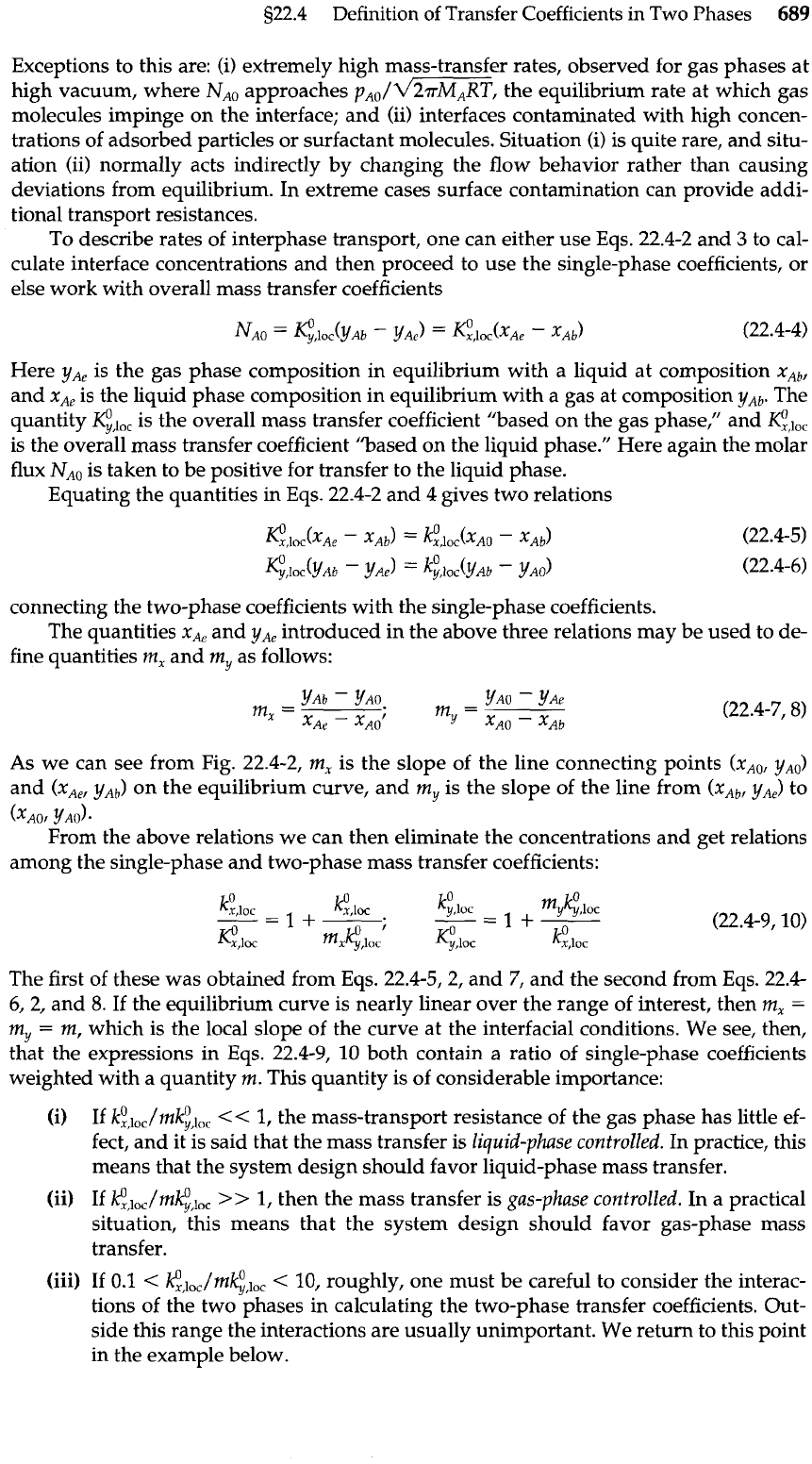
s22.4
Definition of Transfer Coefficients in Two Phases
689
Exceptions to this are: (i) extremely high mass-transfer rates, observed for gas phases at
high vacuum, where
N,,
approaches pAO/s~, the equilibrium rate at which gas
molecules impinge on the interface; and (ii) interfaces contaminated with high concen-
trations of adsorbed particles or surfactant molecules. Situation (i) is quite rare, and situ-
ation (ii) normally acts indirectly by changing the flow behavior rather than causing
deviations from equilibrium. In extreme cases surface contamination can provide addi-
tional transport resistances.
To describe rates of interphase transport, one can either use Eqs. 22.4-2 and
3
to cal-
culate interface concentrations and then proceed to use the single-phase coefficients, or
else work with overall mass transfer coefficients
Here
yAe
is the gas phase composition in equilibrium with a liquid at composition xAb,
and
x,,
is the liquid phase composition in equilibrium with a gas at composition
yAb.
The
quantity
q,Io,
is the overall mass transfer coefficient "based on the gas phase," and
e,,,,
is the overall mass transfer coefficient "based on the liquid phase." Here again the molar
flux NAO is taken to be positive for transfer to the liquid phase.
Equating the quantities in Eqs. 22.4-2 and 4 gives two relations
connecting the two-phase coefficients with the single-phase coefficients.
The quantities
xA,
and
yAe
introduced in the above three relations may be used to de-
fine quantities
m,
and my as follows:
As we can see from Fig. 22.4-2, m, is the slope of the line connecting points (xAO,
yAO)
and
(x,,,
yAb)
on the equilibrium curve, and my is the slope of the line from
(xAb,
yAe)
to
(~'40,
YAO).
From the above relations we can then eliminate the concentrations and get relations
among the single-phase and two-phase mass transfer coefficients:
The first of these was obtained from Eqs. 22.4-5,2, and
7,
and the second from Eqs. 22.4-
6,2, and
8.
If the equilibrium curve is nearly linear over the range of interest, then
m,
=
my
=
m,
which is the local slope of the curve at the interfacial conditions. We see, then,
that the expressions in Eqs. 22.4-9,
10
both contain a ratio of single-phase coefficients
weighted with a quantity m. This quantity is of considerable importance:
If
k~,loc/rnk~,lo,
<<
1,
the mass-transport resistance of the gas phase has little ef-
fect, and it is said that the mass transfer is liquid-phase controlled. In practice, this
means that the system design should favor liquid-phase mass transfer.
If
kO,,loc/m$,loc
>>
1,
then the mass transfer is gas-phase controlled. In a practical
situation, this means that the system design should favor gas-phase mass
transfer.
If
0.1
<
ko,,loc/m$,loc
<
10, roughly, one must be careful to consider the interac-
tions of the two phases in calculating the two-phase transfer coefficients. Out-
side this range the interactions are usually unimportant. We return to this point
in the example below.

690
Chapter
22
Interphase Transport in Nonisothermal Mixtures
The mean two phase mass transfer coefficients must be defined carefully, and we con-
sider here only the special case where bulk concentrations in the two adjacent phases do
not change significantly over the total mass-transfer surface
S.
We may then define
e,,,
by
so that, when Eq. 22.3-9 is used,
Frequently area mean overall mass transfer coefficients are calculated from area mean
coefficients for the two adjoining phases:
The two mean values in Eqs. 22.4-12 and
13
can be significantly different (see Example
22.4-3).
Oxygen is to be removed from water using nitrogen gas at atmospheric pressure and
20°C
in
the form of bubbles exhibiting internal circulation, as shown in Fig. 22.4-3. Estimate the rela-
Determination
of
the
tive importance of the two mass transfer coefficients
k:
,<,,
and
k:
,,,<.
Let
A
stand for O,,
B
for
Controlling Resistance
H,O, and
c
for
N~.
SOLUTION
We can do this by assuming that the penetration model (see
s18.5)
holds in each phase, so that
7
where
c,
and
cg
are the total molar concentrations in the liquid and gas phases, respectively.
The effective exposure time,
t,,,,
is
the same for each of the phases.
Nitrogen
gas
Oxygen-
,
containing
water
Fig.
22.4-3.
Schematic diagram of an oxygen stripper, in
which oxygen from the water diffuses into the nitrogen
gas bubbles.

522.4 Definition of Transfer Coefficients in Two Phases
691
The solubility of
0,
in water at 20°C is 1.38
X
moles per liter at an oxygen partial
pressure of 760 mm
Hg,
the vapor pressure of water is 17.535 mm
Hg,
and the total pressure
in the solubility measurements is 777.5 mm
Hg.
At 20°C, the diffusivity of
O2
in water is
91AB
=
2.1
X
lop5
cm2/s, and in the gas phase the diffusivity for
O2
-
N2
is
=
0.2 cm2/s.
We can then write
(22.4-15)
Into this we must substitute
It follows that
Therefore, only the liquid-phase resistance is significant, and the assumption of penetration
behavior in the gas phase is not critical to the determination of liquid-phase control. It
may
also be seen that the dominant factor is the low solubility of oxygen in water. One may gener-
alize and state that absorption or desorption of sparingly soluble gases is almost always liq-
uid-phase controlled. Correction of the gas-phase coefficient for net mass transfer is clearly
not significant, and the correction for the liquid phase is negligible.
EXAMPLE
22.4-2
Interaction of Phase
There are many situations for which the one-phase transfer coefficients are not available for
the boundary conditions of the two-phase mass transfer problem, and it is common practice
to use one-phase models in which interfacial boundary conditions are assumed, without re-
Resistances
gard to the interaction of the diffusion processes in the two phases. Such a simplification can
introduce significant errors. Test this approximate procedure for the leaching of a solute
A
from a solid sphere of
B
of radius
R
in an incompletely stirred fluid
C,
so large in volume that
the bulk fluid concentration of
A
can be neglected.
SOLUTION
The exact description of the leaching process is given by the solution of Fick's second law
written for the concentration of
A
in the solid in the region 0
<
r
<
R:
The boundary and initial conditions are:
B.C. 1:
at
r
=
0,
B.C. 2: at
u
=
R,
I.C.: at
t
=
0,
The diffusional process on the liquid side of the solid-liquid interface is described in terms of
a mass transfer coefficient, defined by
in which
c,,(t)
is the concentration in the liquid phase adjacent to the interface. The behavior of
the diffusion in the two phases is coupled through Eq. 22.4-22, which describes the equilibrium
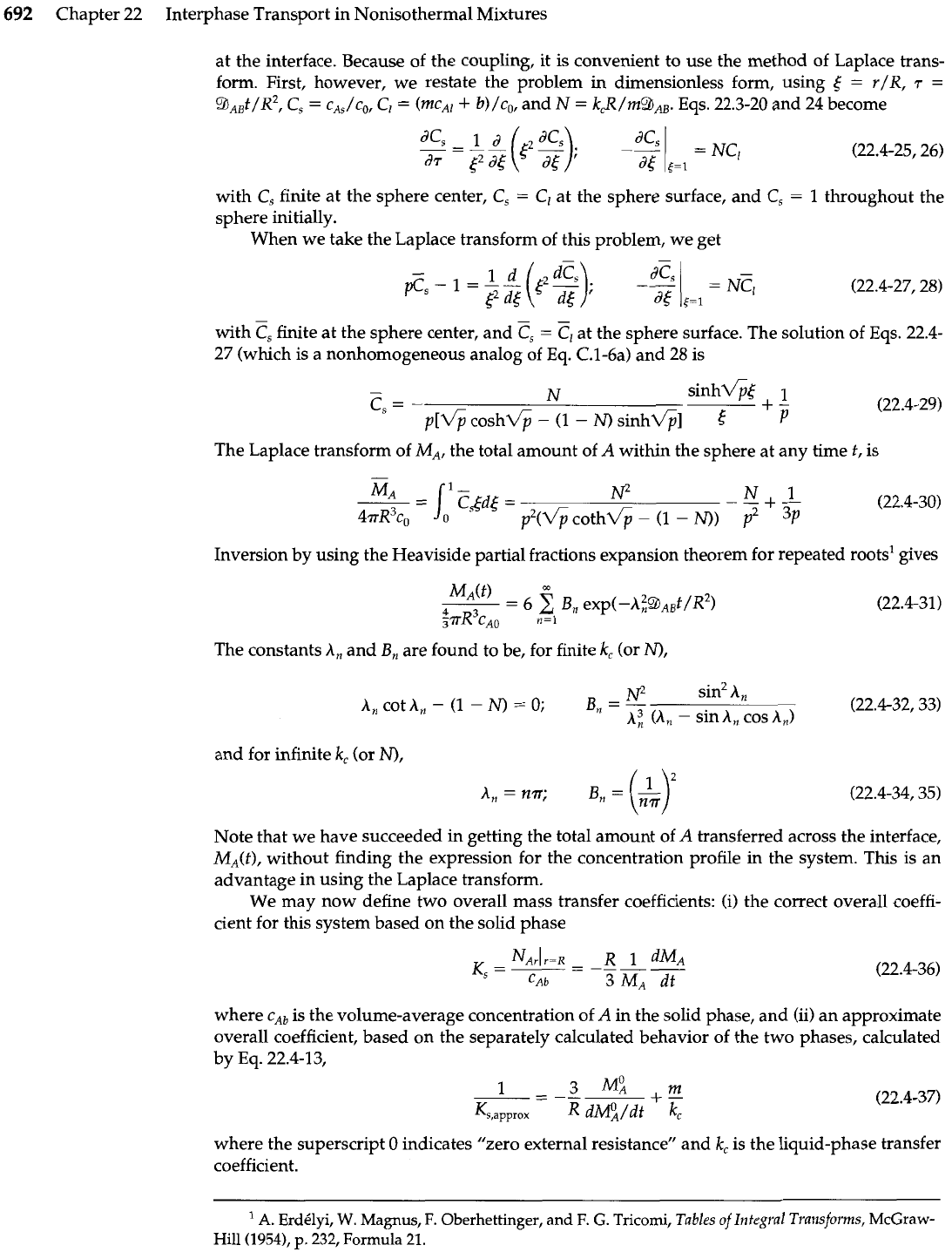
692
Chapter 22 Interphase Transport in Nonisothermal Mixtures
at the interface. Because of the coupling, it is convenient to use the method of Laplace trans-
form. First, however, we restate the problem
in
dimensionless form, using
,$
=
r/R,
T
=
BABt/R2, Cs
=
CAs/Co,
C1
=
(mCAl
+
b)/Co,
and
N
=
k$./m%AB. E~s. 22.3-20 and 24 become
with C, finite at the sphere center, C,
=
C1 at the sphere surface, and C,
=
1
throughout the
sphere initially.
When we take the Laplace transform of this problem, we get
with
Cs
finite at the sphere center, and
C,
=
Cl
at the sphere surface. The solution of Eqs. 22.4-
27 (which is a nonhomogeneous analog of Eq. C.l-6a) and 28 is
The Laplace transform of MA, the total amount of
A
within the sphere at any time t, is
Inversion by using the Heaviside partial fractions expansion theorem for repeated roots' gives
The constants
A,
and
B,
are found to be, for finite
kc
(or
N),
I\IZ
sin2
A,
A,
cot
A,
-
(1
-
N)
=
0;
B
=
-
hi
(A,
-
sin
A,
cos
A,)
(22.4-32,33)
and for infinite
kc
(or
N),
Note that we have succeeded in getting the total amount of
A
transferred across the interface,
MA(t), without finding the expression for the concentration profile in the system. This is an
advantage in using the Laplace transform.
We may now define two overall mass transfer coefficients: (i) the correct overall coeffi-
cient for this system based on the solid phase
where cAb is the volume-average concentration of
A
in the solid phase, and (ii) an approximate
overall coefficient, based on the separately calculated behavior of the two phases, calculated
by Eq. 22.4-13,
where the superscript 0 indicates "zero external resistance" and
kc
is the liquid-phase transfer
coefficient.
A.
Erdelyi,
W.
Magnus, F.
Oberhettinger,
and
F.
G.
Tricomi,
Tables of Integral Transforms,
McGraw-
Hill
(1954),
p.
232,
Formula
21.
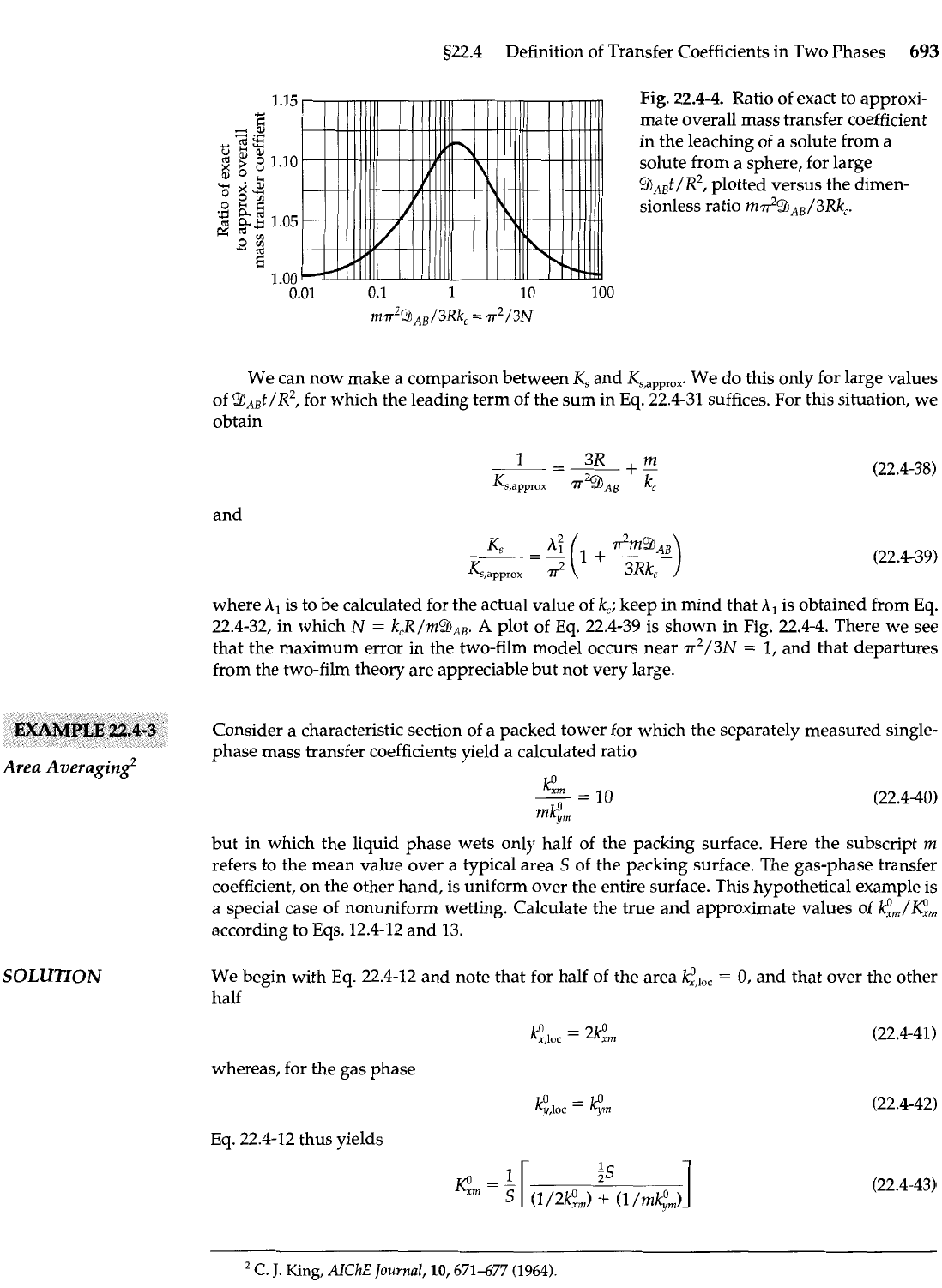
522.4 Definition of Transfer Coefficients in Two Phases
693
1.15
Fig. 22.4-4. Ratio of exact to approxi-
Y
fi
mate overall mass transfer coefficient
=
.Y
d2
a%
in the leaching of a solute from a
z
$
8
1.10
solute from a sphere, for large
m
o
::
WS~I
9*,t/R2, plotted versus the dimen-
0
0%
0
7+
E;
'3
a*
sionless ratio md9,,/3RkC.
a
1.05
T%
*
a
E
0.01
0.1 1 10 100
m?~~c$l~~/3~k,
=
p2/3~
We can now make a comparison between
K,
and
Ks,app,ox.
We do this only for large values
of 9,,t/R2, for which the leading term of the sum in
Eq.
22.4-31 suffices. For this situation, we
obtain
and
where
A,
is to be calculated for the actual value of
kc;
keep in mind that
A,
is obtained from
Eq.
22.4-32, in which
N
=
kJ!/mgA,.
A
plot of
Eq.
22.4-39 is shown in Fig. 22.4-4. There we see
that the maximum error in the two-film model occurs near
r2/3N
=
1, and that departures
from the two-film theory are appreciable but not very large.
Consider
a
characteristic section of a packed tower for which the separately measured single-
phase mass transfer coefficients yield a calculated ratio
Area Averagin$
ln
but in which the liquid phase wets only half of the packing surface. Here the subscript m
refers to the mean value over a typical area
S
of the packing surface. The gas-phase transfer
coefficient, on the other hand, is uniform over the entire surface. This hypothetical example is
a special case of nonuniform wetting. Calculate the true and approximate values of
k:,,/C,
according to Eqs. 12.4-12 and 13.
SOLUTION
We begin with
Eq.
22.4-12 and note that for half of the area
=
0, and that over the other
half
whereas, for the gas phase
k!,~oc
=
k0ym
Eq.
22.4-12 thus yields
C.
J.
King,
AIChE
Journal,
10,671-677 (1964).
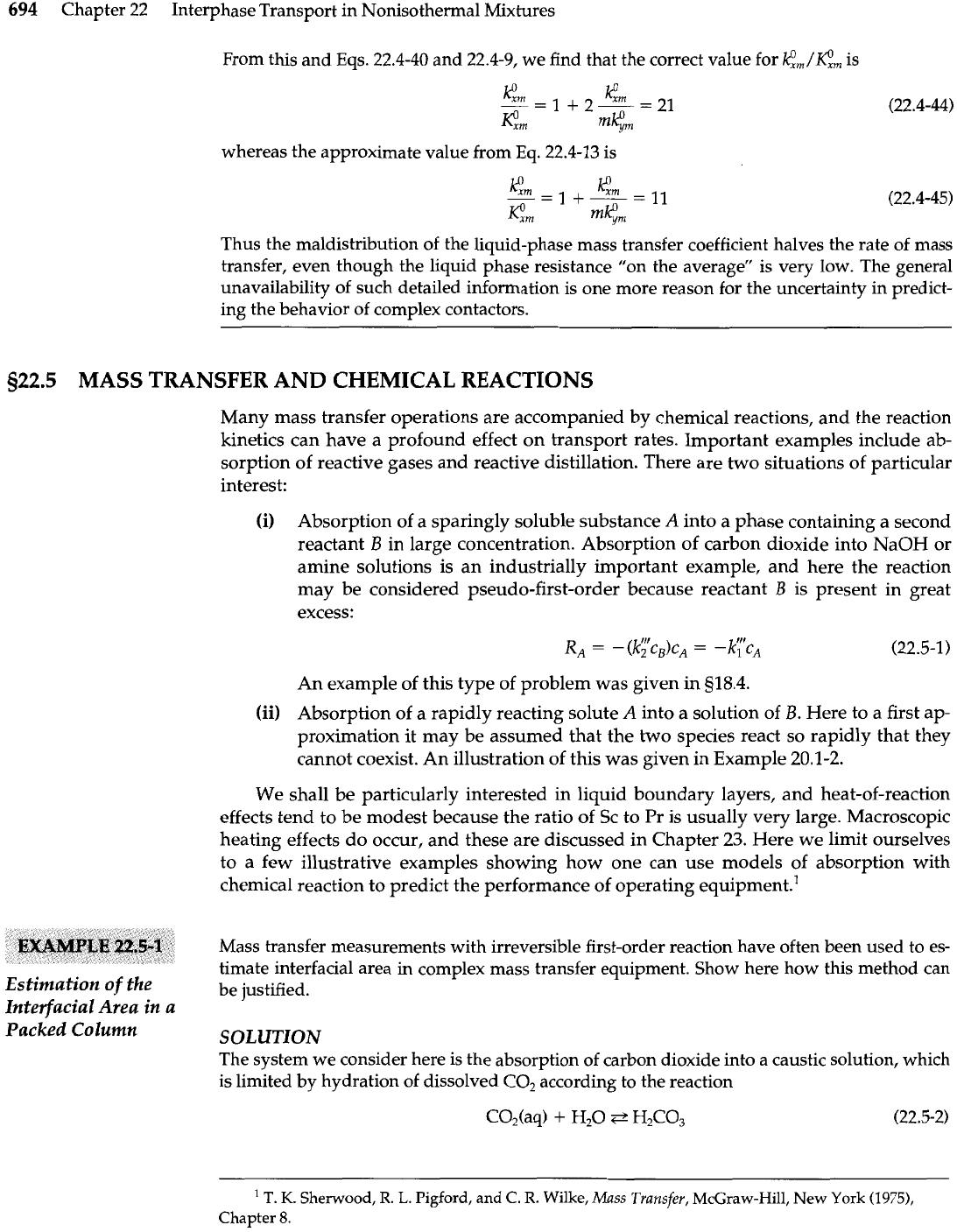
694
Chapter 22 Interphase Transport in Nonisothermal Mixtures
From this and Eqs. 22.4-40 and 22.4-9, we find that the correct value for
k;,/grn
is
whereas the approximate value from
Eq.
22.4-13 is
Thus the maldistribution of the liquid-phase mass transfer coefficient halves the rate of mass
transfer, even though the liquid phase resistance "on the average" is very low. The general
unavailability of such detailed information is one more reason for the uncertainty in predict-
ing the behavior of complex contactors.
522.5
MASS TRANSFER AND CHEMICAL REACTIONS
Many mass transfer operations are accompanied by chemical reactions, and the reaction
kinetics can have a profound effect on transport rates. Important examples include ab-
sorption of reactive gases and reactive distillation. There are two situations of particular
interest:
(i)
Absorption of a sparingly soluble substance
A
into a phase containing a second
reactant
B
in large concentration. Absorption of carbon dioxide into NaOH or
amine solutions is an industrially important example, and here the reaction
may be considered pseudo-first-order because reactant
B
is present in great
excess:
An example of this type of problem was given
in
918.4.
(ii)
Absorption of a rapidly reacting solute
A
into a solution of
B.
Here to a first ap-
proximation it may be assumed that the two species react so rapidly that they
cannot coexist. An illustration of this was given in Example
20.1-2.
We shall be particularly interested in liquid boundary layers, and heat-of-reaction
effects tend to be modest because the ratio of Sc to Pr is usually very large. Macroscopic
heating effects do occur, and these are discussed in Chapter
23.
Here we limit ourselves
to a few illustrative examples showing how one can use models of absorption with
chemical reaction to predict the performance of operating equipment.'
EXAMPLE
22.5-1
Estimation of the
Mass transfer measurements with irreversible first-order reaction have often been used to es-
timate interfacial area in complex mass transfer equipment. Show here how this method can
be justified.
Interfacial Area in a
Packed
Coluwn
SOLUTION
The system we consider here is the absorption of carbon dioxide into a caustic solution, which
is limited by hydration of dissolved C02 according to the reaction
'
T.
K.
Shemood,
R.
L.
Pigford, and C.
R.
Wilke,
Mass Transfer,
McGraw-Hill, New
York
(1975),
Chapter
8.
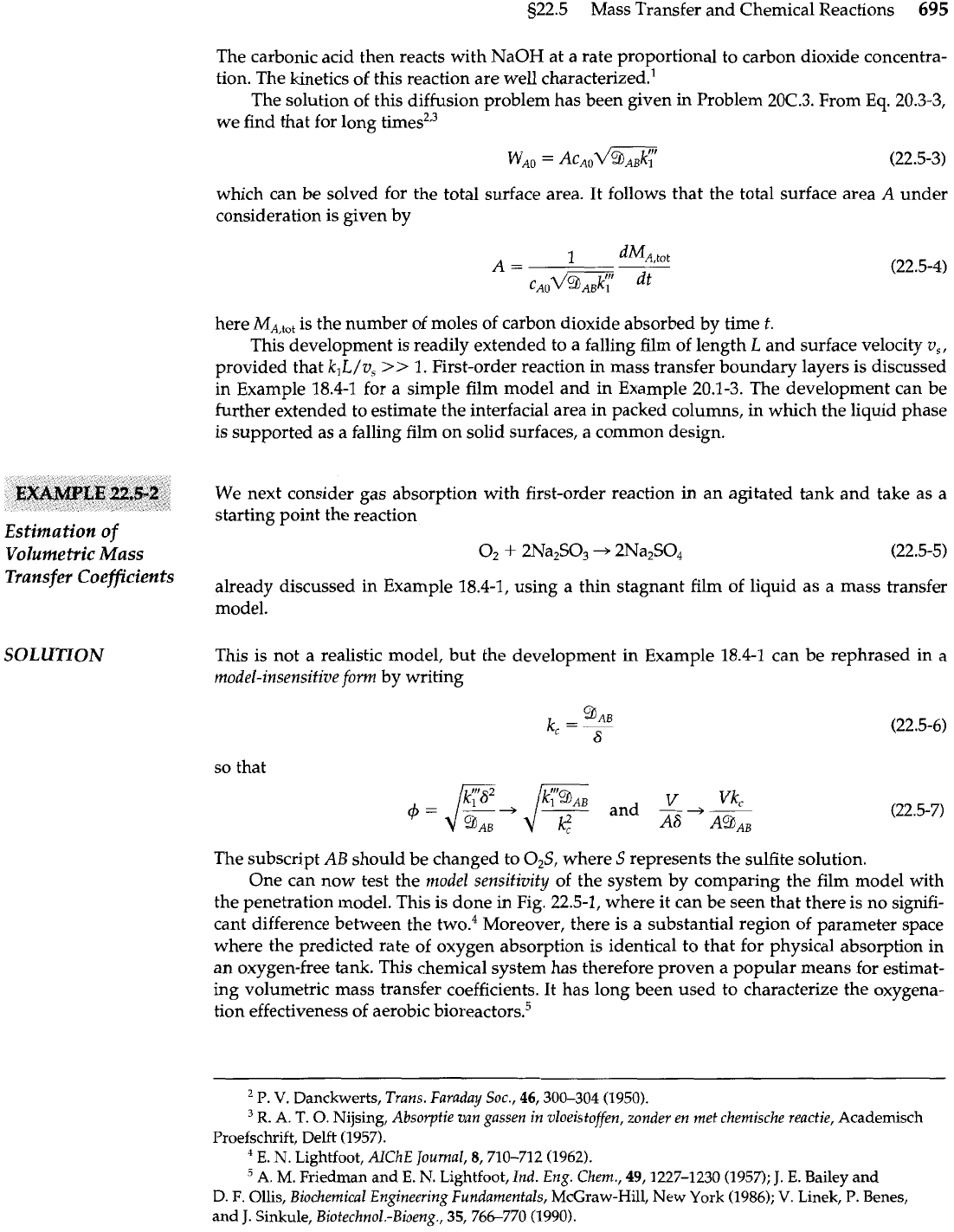
522.5
Mass Transfer and Chemical Reactions
695
The carbonic acid then reacts with NaOH at a rate proportional to carbon dioxide concentra-
tion. The kinetics of this reaction are well characterized.'
The solution of this diffusion problem has been given in Problem 20C.3. From
Eq.
20.3-3,
we find that for long times2r3
WAD
=
(22.5-3)
which can
be
solved for the total surface area. It follows that the total surface area
A
under
consideration is given by
here
MA,tot
is the number of moles of carbon dioxide absorbed by time
t.
This development is readily extended to a falling film of length
L
and surface velocity v,,
provided that k,L/v,
>>
1.
First-order reaction in mass transfer boundary layers is discussed
in Example 18.4-1 for a simple film model and in Example 20.1-3. The development can be
further extended to estimate the interfacial area in packed columns, in which the liquid phase
is supported as a falling film on solid surfaces, a common design.
We next consider gas absorption with first-order reaction in an agitated tank and take as a
starting point the reaction
Estimation of
Volumetric Mass
O2
+
2Na2S03
+
2Na2S04 (22.5-5)
Transfer
Coefficients
already discussed in Example 18.4-1, using a thin stagnant film of liquid as a mass transfer
model.
SOLUTION
This is not a realistic model, but the development
in
Example 18.4-1 can be rephrased in a
model-insensitive form by writing
so that
The subscript
AB
should be changed to 02S, where S represents the sulfite solution.
One can now test the model sensitivity of the system by comparing the film model with
the penetration model. This is done in Fig. 22.5-1, where it can be seen that there is no signifi-
cant difference between the two.4 Moreover, there is a substantial region of parameter space
where the predicted rate of oxygen absorption is identical to that for physical absorption in
an oxygen-free tank. This chemical system has therefore proven a popular means for estimat-
ing volumetric mass transfer coefficients. It has long been used to characterize the oxygena-
tion effectiveness of aerobic biorea~tors.~
P.
V.
Danckwerts, Trans. Faraday Soc.,
46,300-304 (1950).
R.
A.
T.
0.
Nijsing, Absorptie
van
gassen
in
vloeistoffen,
zonder
en
met
chemiscke
reactie, Academisch
Proefschrift, Delft
(1957).
E.
N.
Lightfoot,
AlChE
Journal,
8,710-712 (1962).
A.
M.
Friedman and
E.
N.
Lightfoot, Ind. Eng. Chern.,
49,1227-1230 (1957);
J.
E.
Bailey and
D.
F.
Ollis,
Biochemical
Engineering Fundamentals, McGraw-Hill, New
York
(1986);
V.
Linek,
P.
Benes,
and
J.
Sinkule, Biotechno1.-Bioen,
35,766-770 (1990).
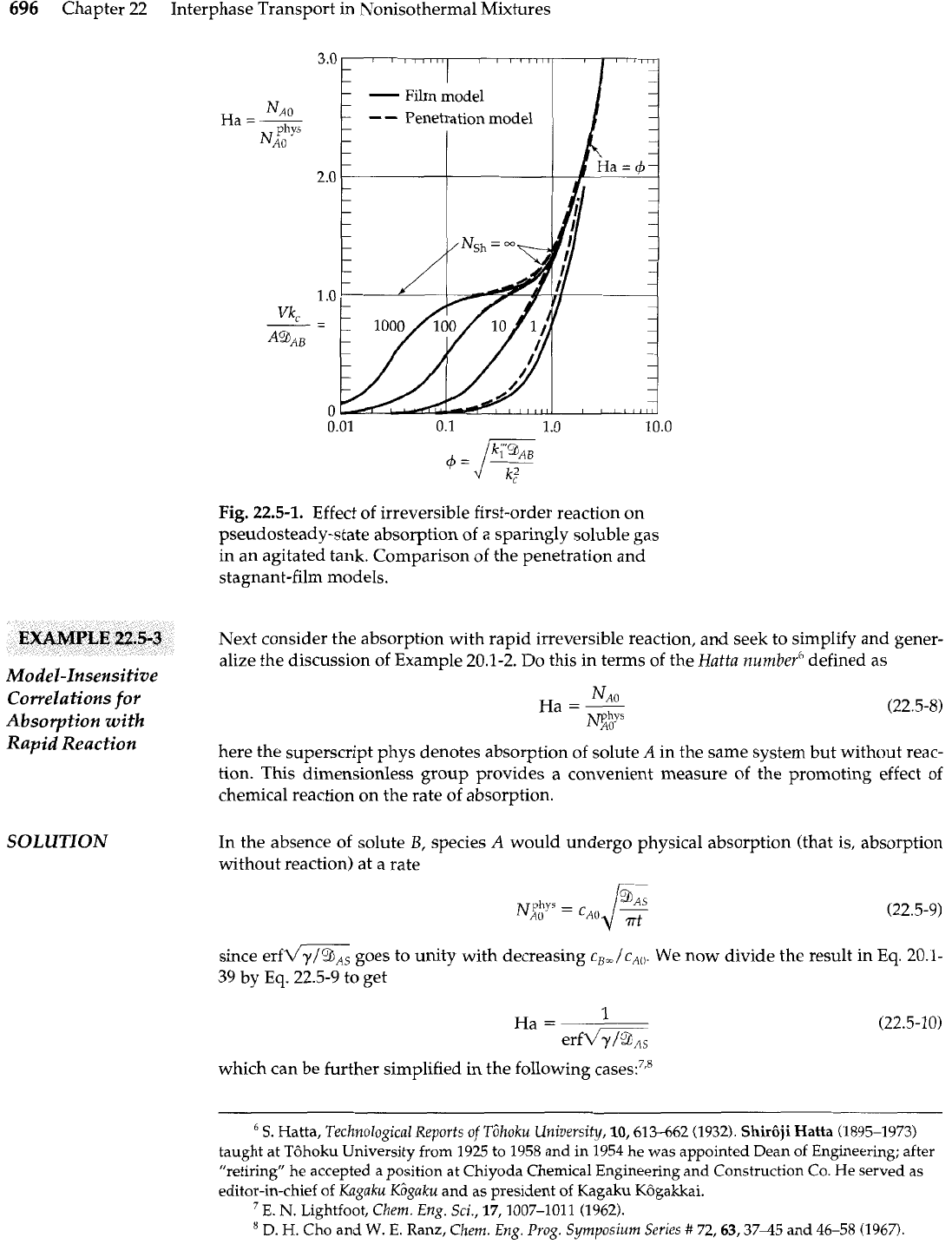
696
Chapter
22
Interphase Transport in Nonisothermal Mixtures
Fig.
22.5-1.
Effect of irreversible first-order reaction on
pseudosteady-state absorption of a sparingly soluble gas
in an agitated tank. Comparison of the penetration and
stagnant-film models.
Next consider the absorption with rapid irreversible reaction, and seek to simplify and gener-
alize the discussion of Example 20.1-2. Do this in terms of the
Hatta
numbeuqefined as
Model-Insensitive
Correlations
for
Ha
=
-
N~o
jphvs
(22.5-8)
Absorption with
A
O'
~a~id Reaction
here the superscript phys denotes absorption of solute
A
in the same system but without reac-
tion. This dimensionless group provides a convenient measure of the promoting effect of
chemical reaction on the rate of absorption.
SOLUTION
In the absence of solute
B,
species
A
would undergo physical absorption (that is, absorption
without reaction) at a rate
since erfV'x goes to unity with decreasing
c,,/c,,,.
We now divide the result in
Eq.
20.1-
39 by
Eq.
22.5-9 to get
which can be further simplified in the following
S.
Hatta,
Technological Reports of
TGhoku
University,
10,613462 (1932).
ShirBji
Hatta
(1895-1973)
taught at TBhoku University from
1925
to
1958
and in
1954
he was appointed Dean of Engineering; after
"retiring" he accepted a position at Chiyoda Chemical Engineering and Construction Co. He served as
editor-in-chief of
Kagaku K6gaku
and as president of Kagaku K6gakkai.
E.
N.
Lightfoot,
Chem.
Eng.
Sci.,
17,1007-1011 (1962).
D.
H.
Cho and
W.
E.
Ranz,
Chem.
Eng.
Puog. Symposium Series
#
72,63,3745
and
46-58 (1967).
